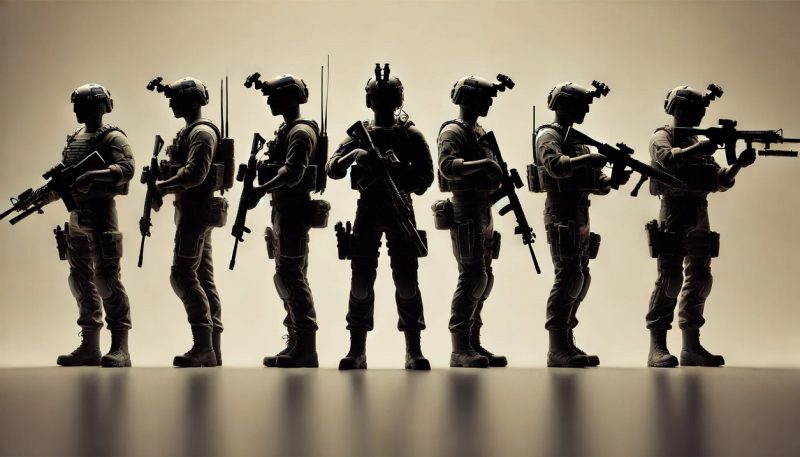Since the beginning of the Russian invasion on February 24th, Ukrainian armed forces have gotten a lot of new weaponry. Some of it was received as donations, much was purchased, and a good amount was captured. Today we will talk about the top five machine guns used by the Ukrainian Armed Forces. Note that we are only listing belt-fed general-purpose machine guns.
PKM
If Michael Kalashnikov should be proud of his inventions, the general-purpose machine gun made under his leadership is the one. The weight of only 7.5 kg, the simplicity of a standard AK rifle, and the stamped receiver make this machine gun unique and comfortable—for both the manufacturer and the end user. Every war since the Soviet invasion of Afghanistan has proved that it is a gun of choice for ground troops.
These are usually seen in two versions – the older PK and the more modern PKM – “Modernised.” The PKM is almost one and a half kilos lighter than its predecessor and is far more common than the older PK.
After the collapse of the Soviet Union, Ukraine had a vast stock of these machine guns. Given that every platoon was supposed to have at least one hand-held PKM machine gun, it is no wonder, so many of them were produced. It is worth noting that every battle vehicle is also equipped with the tank version of the famous machine gun, designated as PKT, where T stands for “tank version.”

After the collapse of the Soviet Union, both infantry and tank versions of PKM were produced locally under the designation KT-7.62. They can be easily distinguished by their black plastic furniture and soft ammo belt pouches.
Overall, these are excellent machine guns with a long service history and combat history. Given the simplicity and similarity to the regular AK rifle, it takes very little time to train anyone within the Ukrainian forces to operate the machine gun. Combined with modern optics, it can hit targets up to 1200 meters.
MG-42/59
Since the big invasion at the end of February, many European countries have decided to help Ukraine defend itself. Germany and Italy were among the first to provide some of the small arms they had in stock. Most notably, the famous MG-42 machine gun. Of course, original WW2 MG-42s are now incredibly rare; hence Ukraine was provided with its modern variants-Italian MG-42/59 and German MG-3. These are very similar, and the differences between the two are negligible.
Although uncommon for the Ukrainian forces, these are very widely spread and excellent machine guns. They are used by a vast number of militaries across the world and are very common in mainland Europe. Given Ukraine’s plans to join NATO alliances, it makes perfect sense to upgrade to NATO-standard weapons.
It is essential to know that they both use 7.62×51 NATO standard ammunition, soon to become the standard rifle-sized ball for Ukrainian forces. The 7.62×54 rounds used by PKM machine guns are not infinite and are generally not as good and easy to produce as modern NATO ammunition.
M240
The legendary machine gun is used by nearly half of the world. Initially known as the Belgium-made FN MAG, it was adopted by a considerable number of the biggest and most professional militaries across the globe—from Sweden to the USA. At the same weight as the MG-3 (11.5 kg), this machine gun gives very stable accuracy at a high rate of fire. They are also well known for their robustness and reliability, even in the worst possible weather conditions—and this is a big argument in the Russo-Ukraine war.

It is worth noting that the Ukrainian army is only supplied with these machine guns by the US Army. Unlike other equipment, the US sends the most modern and well-modified M240s to the front line. However, there are not too many pictures of Ukrainians using these machine guns either in training or battle, which leads us to believe that these were not delivered in large numbers.
Anyway, there is a high probability that Ukraine will start receiving modern US-made fighting vehicles shortly. As all American vehicles are equipped with M240 machine guns, it puts them in good practice using them already.
Pecheneg PKP
This one is my favorite, even though it is not a general-purpose machine gun. Even though most PKM machine guns were equipped with tripods, they were never popular in the Soviet Army. They were also unpopular in any post-Soviet armies. This contrasts highly with NATO armies, where the tripod plays a reasonably important role in the infantry platoon.
When Russian engineers realized that their troops do not use PKM for sustained fire but only in the light role, shooting from the bipod, they decided to make a new modification. So they went on and made the Pecheneg. And it was a success!
If you look at a distance, it closely resembles a regular PKM machine gun. First, they equipped new machine plastic stock and, more importantly, an optics rail. It was not different from the Soviet one, which was placed on the PKMs, but only a few PKMs were equipped with these rails. The bipod was moved to the end of the barrel, giving better stability when shooting; this is important for PKM-type machine guns, as they are so light.

But the major change was in the barrel construction. Russian and Soviet infantry rarely bothered carrying additional barrels to change after the first one got too hot. Yet there was still a problem, so engineers tried a different approach. By increasing the diameter of the barrel and by introducing the “forced cooling” method, the machine gun can now shoot 600 rounds straight before overheating.
The forced cooling system is a tricky but clever invention. Four longitudinal grooves cut into the barrel run from the gas block to the muzzle. The jacket has them covered. The grooves connect four holes in the gas block and four on the front of the muzzle device. Like the Lewis machine gun, low pressure generated at the front of the jacket during firing draws cool air through the grooves, cooling the front part of the barrel.
Russia never supplied these machine guns to Ukraine until 2022, when the Russian forces captured many of them.
UK vz. 59
Last, an example of Czech technology used in modern warfare. The Czech government supplied these machine guns and other weapons and equipment that they had accumulated since the Cold War. At least 3200 of these were given to Ukraine, which makes them a substantial part of the Ukrainian machine gun fleet.
It uses the same ammunition as the standard PKM machine gun and is considerably lighter than most NATO GPMGs. Along with its overall simplicity, it would be a great machine gun. However, some frontline reports suggest that the reliability of the machine gun is questionable. We don’t want to make further conclusions based on this little evidence. Still, there are not too many photos of these machine guns being used on the frontline, but mostly with territorial defense units in the rear echelons.






